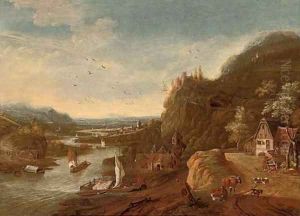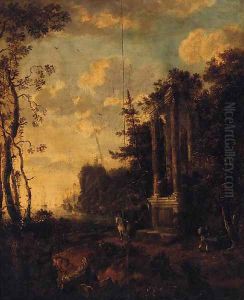Jan Griffier II Paintings
Jan Griffier II was a Dutch painter born in 1688 in Amsterdam, the Netherlands. He was the son of Jan Griffier the Elder, who was also an accomplished artist, and it is believed that he was trained by his father. Jan Griffier II is often confused with his father due to the similarity in their names and because they both painted similar subjects, including landscapes and river scenes.
Jan Griffier II worked primarily in England, where he moved with his father in the late 17th century. His father had established a successful career there, with a clientele that included the English aristocracy. Like his father, Griffier II painted views of the Thames and the English countryside, often focusing on the lush, verdant landscapes and the bustling life along the river.
Although he was influenced by his father's work, Jan Griffier II developed his own style. His paintings are characterized by a softer palette and a more rococo feel, which was in line with the changing tastes of the early 18th century. He also painted topographical views and was known for his attention to detail and ability to capture the changing effects of light on the landscape.
Griffier II's work was well-regarded, and he was part of the circle of Dutch artists who were active in England at the time, which included the likes of Peter Tillemans and Pieter Andreas Rijsbrack. Despite the popularity of his work during his lifetime, Griffier II's reputation was somewhat overshadowed by that of his father, and after his death in 1750, his work was often mistakenly attributed to Jan Griffier the Elder.
Today, Jan Griffier II's paintings can be found in various art collections and museums, where they are appreciated for their contribution to the Dutch landscape tradition and their depiction of early 18th-century English rural and river scenes.

